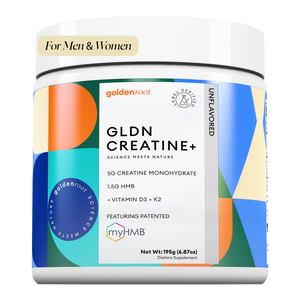For women seeking to boost energy, sculpt lean muscle, and recover more quickly, creatine is one of the most underrated yet powerful supplements available.
But not all creatine is the same. Two of the most popular types, creatine monohydrate and micronized creatine, offer slightly different benefits, particularly in terms of digestibility, solubility, and performance.
So, which one is best for women?
Let’s clear some misconceptions by exploring more!
##creatine-calc
What Does Creatine Do for Women?
Creatine helps fuel your muscles and brain by increasing levels of ATP (adenosine triphosphate), your body’s main source of energy for short, explosive movements like lifting weights, sprinting, or high-intensity workouts.
Women who supplement with creatine often see:
-
Improved muscle tone and strength
-
Faster muscle recovery
-
Increased energy and stamina
- Potential support for cognitive function
Read more: The Best Creatine for Women: How to Choose the Right One for Your Fitness Goals
Common Myths About Creatine and Women
-
"It’ll make me bulky." → False. Creatine supports lean muscle, not massive size.
-
"It causes bloating." → Not in most cases, especially with proper dosing.
- "It’s only for men or bodybuilders." → Not at all. It’s safe and beneficial for women of all fitness levels.
What Is Creatine Monohydrate?
Creatine monohydrate is the most studied and clinically proven form of creatine. It’s made by combining one molecule of creatine with one molecule of water.
Why Is It the Most Popular Form?
-
Backed by over 1,000 studies
-
Widely available and cost-effective
- Considered the "gold standard" of creatine
Key Benefits for Women
-
Supports lean muscle gain (not bulk)
-
Reduces muscle fatigue
-
Helps with strength and performance
- May improve brain function and mood (especially during PMS or perimenopause)
What Is Micronized Creatine?
Micronized creatine is essentially creatine monohydrate broken into smaller particles through a mechanical process. This doesn’t alter its chemical structure, but it improves how it behaves in your body.
Read more: The Best Creatine for Women: Top Types, Benefits & Myths Busted
What Does “Micronized” Mean?
It means the creatine particles are up to 20 times smaller than standard monohydrate. This can help with:
-
Faster mixing in liquids
-
Better absorption
- Less grit or clumping
Does Micronized Creatine Work Faster?
While both forms deliver the same creatine to your muscles, micronized creatine may be easier on digestion and mix more efficiently, making it an ideal choice for women who prefer a smoother supplement experience.
Micronized vs. Monohydrate: Key Differences for Women
Let’s break down how these two types compare specifically for women.
Purity and Absorption
-
Micronized Creatine: Smaller particles = potentially faster absorption and gentler on the digestive system. Women prone to bloating may prefer this version.
- Monohydrate: Pure and effective, but some users report stomach discomfort or mild bloating in the early days.
Mixability and Taste
-
Micronized Creatine: Mixes smoothly into water, smoothies, or juice with minimal texture.
-
Monohydrate: May clump or settle to the bottom if not stirred thoroughly, but blends smoothly with a shaker bottle.
Read more: Can Creatine Improve Cognitive Performance During Sleep Deprivation?
Cost and Value
-
Micronized Creatine: Typically more expensive due to extra processing.
- Monohydrate: More affordable and widely available, making it a better value if you're not sensitive to mixability.
Which One Is Better for Women’s Fitness Goals?
Both types of creatine can be beneficial for women, but your goals and preferences will help you determine which one is best for you.
Best for Toning and Lean Muscle
Both forms support lean muscle growth. However, micronized creatine may be easier to digest, which can be appealing if you're using it during cutting or toning phases.
Best for Beginners vs. Advanced Users
-
Beginners: Start with creatine monohydrate; it’s affordable, effective, and readily available.
- Advanced users or those with sensitive stomachs: Try micronized creatine for better solubility and smoother digestion.
Read more: How to Measure 5g of Creatine: Teaspoons, Tablespoons, and Simple Methods That Work!
Side Effects Differences?
Side effects are rare for both. However:
-
Some women report bloating or cramping with monohydrate.
- Micronized creatine is often better tolerated and less likely to cause GI discomfort.
How to Use Either Type Safely
How Much Should Women Take Daily?
-
Recommended dose: 3–5 grams per day
- There is no need for a "loading phase" unless you're experienced and know how your body responds.
Can You Switch Between the Two?
Yes. Since micronized creatine is just a finer form of monohydrate, switching between them won’t disrupt your progress. Just keep your dose consistent.
Best Time to Take Creatine for Women
-
After workouts is best for most.
- Or take it any time of day; if you're consistent, creatine works by building up in your muscles over time.
Read more: is creatine safe while breastfeeding
Which Creatine Should Women Choose?
Both creatine monohydrate and micronized creatine offer real benefits, but the right choice depends on your needs.
Creatine monohydrate is the gold standard, affordable, well-researched, and effective for most women. It may not mix as smoothly, but its proven results make it a strong go-to.
Micronized creatine, although slightly more expensive, offers better mixability and gentler digestion, making it ideal for women with sensitive stomachs or those who prioritize ease of use.
Reference:
- https://www.ncbi.nlm.nih.gov/books/NBK553175/
- https://ironperformance.ca/creatine-the-gold-standard-supplement/



